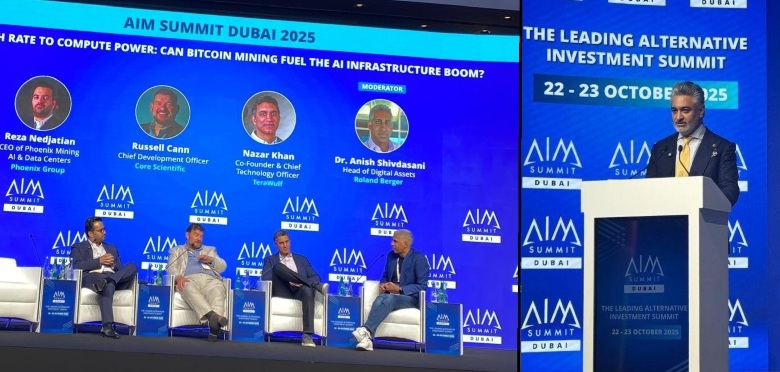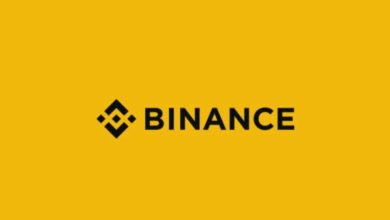Crypto Miners Pivot to AI Without Leaving the Core: From Hashpower to Compute Power

At the AIM Summit in Dubai, one theme kept resurfacing on stage: Bitcoin miners are not fading out — they’re scaling up.
In his keynote, Munaf Ali, Group CEO of Phoenix, laid out how miners are moving into artificial intelligence infrastructure without abandoning Bitcoin. He described it as continuity, not abandonment: “The progression from mining to AI isn’t a pivot; it’s a continuum.”
Later on, a panel titled “From Hash Rate to Compute Power: Can Bitcoin Mining Fuel the AI Infrastructure Boom?” brought that idea into focus, moving from philosophy to numbers, financing, and risk.
Mining Meets AI: Evolution, Not Exit
For over a decade, miners have been the backbone of Bitcoin’s security and stability. Despite market downturns and rising operational costs, the industry has consistently adapted. As Ali told the audience, “From the very beginning, people asked when miners would disappear. Now, the question has evolved: will miners disappear and be replaced by AI or super compute companies? The truth is, the progression from mining to AI isn’t a pivot; it’s a continuum.”
Both worlds are bound by the same formula — turning energy into computation and computation into economic value. What was once a system for verifying trust in digital money is now evolving into infrastructure that powers machine intelligence.
Shared DNA: Power, Efficiency, and Agility
Ali’s keynote made clear that Bitcoin miners are not starting from scratch. Their infrastructure — optimized for efficiency and scalability — is already aligned with AI’s requirements.
Phoenix’s facilities operate at a Power Usage Effectiveness (PUE) of just 1.1. “Every watt becomes productive computation,” Ali said, emphasizing that power efficiency, not just raw energy, defines competitiveness.
While new AI players scramble to solve energy access and cooling challenges, miners have been doing it for years. “When I hear talk of power scarcity as a ‘new challenge,’ I smile — because that’s exactly how we’ve been operating since the beginning,” Ali remarked.
The Financial Frontier: Why AI Changes the Game
The next panel brought additional context. Reza Nedjatian, CEO of Phoenix Mining, highlighted the financial advantage AI brings to mining companies.
“It’s easier to finance 60 to 70 percent of an AI data center,” he explained, “because these projects come with long-term contracts that can lock in 10 to 15 years of predictable revenue.”
That stands in sharp contrast to the mining sector, where expansions and upgrades often require 100% CapEx with uncertain payback periods tied to Bitcoin’s price.
AI’s financing model — backed by hyperscaler contracts and predictable cash flow — gives miners access to traditional debt and institutional capital. This makes AI not just a technological expansion, but a financial evolution for the industry.
Between Opportunity and Overheating
The panel’s moderator, Dr. Anish Shivdasani, Head of Digital Assets at Roland Berger, brought a measured perspective. “Many publicly listed Bitcoin miners are switching from BTC mining to AI infrastructure,” he said. “They already have access to land, power, and data-center expertise — all crucial to AI infrastructure.”
But he also warned of growing risks: “The CapEx required for AI data centers is 10 to 20 times that of Bitcoin mines. While investor appetite and long-term contracts make these projects appealing, the key question is whether this massive spending will yield sustainable returns.”
He cautioned that the rush into AI could mirror speculative cycles familiar to crypto veterans: “There’s a real risk we are in an AI bubble — and if it pops, someone will be left holding the bag.”
The Decentralization Effect
Ironically, as large mining operators redirect resources toward AI, smaller and private miners may seize the opportunity to expand Bitcoin’s hashrate.
This shift could lead to a more decentralized mining landscape, reversing the trend of concentration among a few industrial-scale players. Localized miners, equipped with agile setups and regional energy deals, may help restore some of the network’s early diversity.
The result? AI may not replace Bitcoin mining — it might reshape it, redistributing power and reaffirming Bitcoin’s foundational ethos: decentralization.
Frontier Builders, Once Again
Ali described miners as “frontier builders” — pioneers who turn invisible energy into digital value. That mindset, he said, is what allows them to adapt to the AI era.
“For us, the line from Bitcoin to AI isn’t a leap — it’s an evolutionary gradient,” Ali noted. “Energy became trust. Trust became value. Value became compute. And now, compute is becoming intelligence.”
Phoenix was the first to establish large-scale Bitcoin mining in the Middle East and Africa, transforming deserts into hubs of digital infrastructure. Today, it is leading the region’s next phase — building AI compute capacity from the same foundations that once powered the blockchain revolution.
And as Ali reminded the audience: “The miners aren’t going anywhere. We are evolving — and we are here to stay.”





